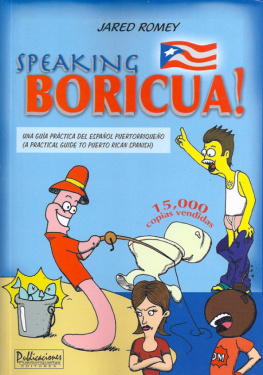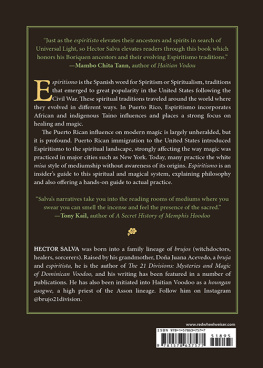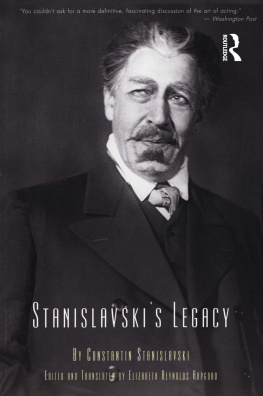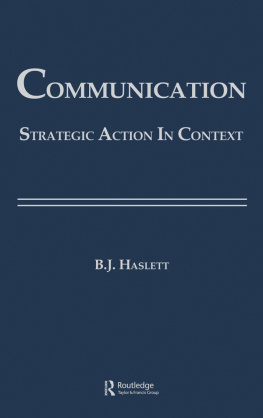IMAGES AND IDENTITIES
IMAGES AND IDENTITIES
The Puerto Rican in Two World Contexts
Edited by
Asela Rodrguez de Laguna
First published 1987 by Transaction Publishers
Published 2017 by Routledge
2 Park Square, Milton Park, Abingdon, Oxon OX14 4RN
711 Third Avenue, New York, NY 10017, USA
Routledge is an imprint of the Taylor & Francis Group, an informa business
Copyright 1987 by Taylor & Francis
All rights reserved. No part of this book may be reprinted or reproduced or utilised in any form or by any electronic, mechanical, or other means, now known or hereafter invented, including photocopying and recording, or in any information storage or retrieval system, without permission in writing from the publishers.
Notice:
Product or corporate names may be trademarks or registered trademarks, and are used only for identification and explanation without intent to infringe.
Library of Congress Catalog Number: 85-9930
Library of Congress Cataloging in Publication Data
Main entry under title:
Images and identities
Bibliography: p.
1. Puerto Rican literatureCongresses. 2. American literaturePuerto Rican authorsCongresses. 3. Puerto Ricans in literatureCongresses. I. Rodrguez-Seda de Laguna, Asela.
PQ7420.15.143 1986 860.997295 85-9930
ISBN 0-88738-060-3
ISBN 0-88738-617-2 (pbk.)
This publication was made possible partially by a grant from the New Jersey Committee for the Humanities, a state program of the National Endowment for the Humanities.
ISBN 13: 978-0-88738-617-6 (pbk.)
To my daughters
Aselita, Mara Eugenia, and Alexandra Mara
Contents
Jose Luis Gonzalez
Luis Rafael Sanchez
Pedro Juan Soto
Gerald Guinness
Bonnie Hildebrand Reynolds
Frank Dauster
Marvin A. Lewis
Margarite Fernndez Olmos
Barry B. Levine
Norma Carr
Magali Garca Ramis
Edgardo Rodrguez Juli
Edgardo Sanabria Santaliz
Juan Antonio Ramos
Carmen Lugo Filippi and Ana Lydia Vega
Piri Thomas
Nicholasa Mohr
Miguel Algarn
Sandra Maria Estves
Sandra Mara Estves
Orlando Jose Hernandez
Gerald Guinness
Angel G. Quintero Alfaro
Sonia Nieto
Juan Bruce Novoa
Nicolas Kanellos
John C. Miller
Charles A. Tatum
The first national public conference on Images and Identities: The Puerto Rican in Literature was held at RutgersThe State University of New Jersey, Newark, the Newark Public Library and The Newark Museum, April 79, 1983. Although it would be impossible to acknowledge the collaboration of everyone who assisted me with the conference, I would like to express my gratitude to a number of people for their support and advice: Luis Alonso, Judith K. Brodsky, Alan S. Brown, Erma Brown, James Early, Danilo Figueredo, Pat Hynes, David Hosford, Michael C. Jaye, Beatrice Lasker, Miriam Murphy, Jos R. Olmo- Olmo, Miguel A. Rivera, Marcial Robiou, Alfredo Santiago, Dirk B. Van Zaanen, Francisco Vzquez, Ann C. Watts, and Hildreth York; and the students from Federatin de Estudiantes Latinoamericanos, Puerto Rican Organization, Club Cultural Cubano, and Crculo de Espaol. Special recognition is due for his important participation during opening events to the Honorable Governor of New Jersey, Thomas H. Kean; the president of RutgersThe State University of New Jersey, Dr. Edward J. Bloustein; the provost of Rutgers-Newark, Dr. Norman Samuels; from the New Jersey Committee for the Humanities, the Honorable Judge John L. Bracken; and the executive director of the Fundacin Puertorriquea de las Humanidades, Dr. Arturo Morales Carrin. I thank my husband, Elpidio Laguna, for his cooperation, understanding, trust, steadiness, and support. And, to Jimmy Luciano, who patiently and critically worked not only during the planning and organization of the conference, but also in the preparation, translation, and revision of the works included here, my most sincere gratitude.
The conference and the publication of this book were possible thanks to the generous contribution of several organizations, institutions, foundations and corporations: The National Endowment for the Humanities, The Ford Foundation, The New Jersey Committee for the Humanities, The Geraldine R. Dodge Foundation, Goya Foods, Inc., New Jersey Bell Telephone Company, The Greater Newark Chamber of Commerce, International Ladies Garment Workers Union, New Jersey Region, and The Prudential Foundation. We are greatly indebted to RutgersThe State University of New Jersey, Newark, the Newark Public Library, and The Newark Museum, for their support.
The author gratefully acknowledges the following publishers and publications for permission to use previously published materials:
Miguel Algarn, Nuyorican Aesthetics. Reprinted by permission of MELUS, University of Cincinnati: Cincinnati, Ohio, 1981.
Rosario Ferr, Cuando las mujeres quieren a los hombres, in Papeles de Pandora. Mexico City: Editorial Joaquin Mortiz, S.A., 1976.
Miguel Algarn and Miguel Piero, editors. Nuyorican Poetry. New York: William Morrow and Co., 1975. Special thanks to the poets Miguel Piero, Archie Martnez, and Amrico Casiano.
What Is Puerto Rican Literature?
Answering this question might not require too much effort within the geographic context of the island of Puerto Rico. There, people would offer a wide sample of definitions ranging from very simple and general statements to more sophisticated ones, embodying aspects of the history, politics, and cultural and socioeconomic development of the island. For some, Puerto Rican literature could simply be defined as the literary manifestation of Puerto Ricans; for others, it is the literature of Puerto Ricans, written in Spanish by Puerto Ricans; and still others more academically geared would define aspects of its past and present production through different critical approaches. Outside the insular context, Puerto Rican literature is less known, and only during the last two decades has it enjoyed more diffusion, and consequently, more accessiblility among the Spanish-speaking public. In the United States, but only since the late sixties, it has been moderately tolerated and studied, particularly by academics. This booms raison dtre emerged as the result partly of sociopolitical pressures of the sixties, partly of the efforts of newly established Puerto Rican studies. A general enthusiasm for the ethnic literatures of the United States also encouraged the recognition of Puerto Rican literature and the appreciation of the literature written by Puerto Ricans in the continent. In the United States this literature is seen not only as the national expression of a large sector of the Puerto Rican public but also as testimonial literature of a national minority.
This process of recognition and appreciation of Puerto Rican literature within the sociopolitical context of the past two decades is more accurately a perceptual process in the United States rather than what the terms










